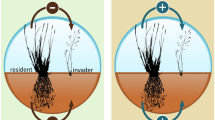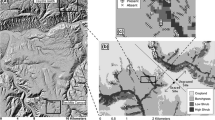Abstract
Effective long-term management of noxious plant species depends on our ability to identify and manage ecological processes-driving invasion and to use site-specific information to design realistic management strategies and goals. However, there is a surprising lack of research that investigates relationships among habitat characteristics, weed demography, and management efforts. We investigated the interactions among these factors using the invasive annual grass medusahead (Elymus caput-medusae). In Yuba County, California, we seeded medusahead in densities from 0 to 50,000 seeds/m2 in open grassland and oak woodland habitats. We also exposed plots to defoliation none, once, or twice in a season and captured how medusahead germination, establishment, and persistence responded to experimental treatments. We found that medusahead establishment was higher in the grassland, compared to the woodland habitat, likely due, in part, to the presence of litter under oak canopies. After a single defoliation event, medusahead persistence was higher in the oak, but not the grassland plots. We also found that defoliation once or twice reduced medusahead density. However, a single clipping treatment actually resulted in increased seed production. This was likely a compensatory response by a younger cohort, and provides an explanation for why single control efforts do not generally result in successful long-term outcomes. This work highlights the complex relationships between density-dependent and density-independent processes that may influence invasion dynamics.




Similar content being viewed by others
References
Amatangelo KL, Dukes JS, Field CB (2008) Responses of a California annual grassland to litter manipulation. J Veg Sci 5:605–612
Arredondo JT, Johnson DA (1998) Clipping effects on root architecture and morphology of 3 range grasses. J Range Manag 51:207–213
Benayas JMR, Navarro J, Espigares T, Nicolau JM, Zavala MA (2005) Effects of artificial shading and weed mowing in reforestation of mediterranean abandoned cropland with contrasting Quercus species. For Ecol Manag 212:302–314
Bradley BA, Blumenthal DM, Early R, Grosholz ED, Lawler JJ, Miller LP, Sorte CJB, D’Antonio CM, Diez JM, Dukes JS, Ibanez I, Olden JD (2012) Global change, global trade, and the next wave of plant invasions. Front Ecol Environ 10:20–28
Buckley YM, Briese DT, Rees M (2003) Demography and management of the invasive plant species Hypericum perforatum. II. construction and use of an individual-based model to predict population dynamics and the effects of management strategies. J Appl Ecol 40:494–507
Cherr CM (2009) Invasion, control, and disturbance of medusahead [Taeniatherum caput-medusae (L.) Neveski] in California grasslands dissertation. University of California, Davis, p 129
D’Antonio CM, Vitousek PM (1992) Biological invasions by exotic grasses, the grass/fire cycle, and global change. Annu Rev Ecol Syst 23:63–87
Davies KW (2008) Medusahead dispersal and establishment in sagebrush steppe plant communities. Range Ecol Manag 61:110–115
Davis AS, Dixon PM, Liebman M (2004) Using matrix models to determine cropping system effects on annual weed demography. Ecol Appl 14:655–668
Davy JS, Roche LM, Robertson AV, Nay DE, Tate KE (2015) Introducing cattle grazing to a noxious weed-dominated rangeland shifts plant communities. Cal Ag 69:230–236
DiTomaso JM (2000) Invasive weeds in rangelands. Species, impacts, and management. Weed Sci 48:255–265
DiTomaso JM, Kyser GB, George MR, Doran MP, Laca EA (2008) Control of medusahead (Taeniatherum caput-medusae) using timely sheep grazing. Inv Plant Sci Manag 1:241–247
Donath TW, Eckstein RL (2008) Grass and oak litter exert different effects on seedling emergence of herbaceous perennials from grasslands and woodlands. J Ecol 96:272–280
Elgersma KJ, Yu S, Vor T, Ehrenfeld JG (2012) Microbial-mediated feedbacks of leaf litter on invasive plant growth and interspecific competition. Plant Soil 356:341–355
Emery SM, Gross KL (2004) Effects of timing of prescribed fire on the demography of an invasive plant, spotted knapweed Centaurea maculosa. J Appl Ecol 42:60–69
Evans RA, Young JA (1970) Plant litter and establishment of alien annual weed species in rangeland communities. Weed Sci 18:697–703
Facelli JM, Pickett STA (1999) Plant litter: light interception and effects on an old-field plant community. Ecology 72:1024–1031
Gillespie IG, Allen EB (2004) Fire and competition in a southern California grassland: impacts on the rare forb Erodium macrophyllum. J Appl Ecol 41:643–652
Goldberg DE, Turkington R, Olsvig-Whittaker L, Dyer A (2001) Density dependence in an annual plant community: variation among life history stages. Ecol Monogr 71:423–446
Gornish ES, James JJ, Laca EA (2015) The value of oak woodland habitats as control for medusahead (Taeniatherum caput-medusae). In: Proceedings of the seventh California oak symposium: managing oak woodlands in a dynamic world, November 3–6, 2014, Visalia, CA. USDA Forest service general technical report PSW-GTR-251,p 579
Hellmann JJ, Byers JE, Bierwagen BG, Dukes JS (2008) Five potential consequences of climate change for invasive species. Cons Biol 22:534–543
Hempy-Mayer K, Pyke DA (2008) Defoliation effects on Bromus tectorum seed production: implications for grazing. Range Ecol Manag 61:116–123
Hironaka M (1961) The relative rate of root development of cheatgrass and medusahead. J Range Manag 14:263–267
Jacquemyn H, Brys R, Jongehans E (2010) Seed limitation restricts population growth in shaded populations of a perennial woodland orchid. Ecology 91:119–129
James JJ, Gornish ES, DiTomaso JM, Davy J, Doran M, Becchetti T, Wilson R, Lile D, Laca E (2015) Managing medusahead (Taeniatherum caput-medusae) on rangeland: a meta analysis of control effects and assessment of stakeholders needs. Range Ecol Manag 68:215–223
Jongejans E, Jorritsna-Wienk LD, Becker U, Dostal P, Milden M, de Kroon H (2010) Region versus site variation in the population dynamics of three short-lived perennials. J Ecol 98:279–289
Keammerer HB, Hacker SD (2013) Negative and neutral marsh plant interactions dominate in early life stages across physical gradients in an Oregon estuary. Plant Ecol 214:303–315
Kuiters AT, Sarink HM (1986) Leaching of phenolic compounds from leaf and needle litter of several deciduous and coniferous trees. Soil Biol Biochem 18:475–480
Kyser GB, Doran MP, McDougald NK, Orloff SB, Vargas RN, Wilson RG, DiTomaso JM (2008) Site characteristics determine the success of prescribed burning for Medusahead (Taeniatherum caput-medusae). Inv Plant Sci Manag 1:376–384
Kyser GB, Peterson VF, Davy JS, DiTomaso JM (2012) Preemergent control of medusahead on California annual rangelands with aminopyralid. Range Ecol Manag 65:418–425
Kyser GB, DiTomaso JM, Davies KW, Davy JS, Smith BS (2014) Medusahead management guide for the western states. University of California, Weed research and information center, Davis p 68. Available at: wric.ucdavis.edu
Lehtila K, Syrjanen K, Leimu R, Garcia MB, Ehrlen J (2006) Habitat change and demography of Primula veris: identification of management targets. Cons Biol 20:833–843
Lusk WC, Jones MB, Torell DT, Kell CMM (1961) Medusahead palatability. J Range Manag 14:248–251
Lytle DJ (1998) Soil survey of Yuba County. United States Department of Agriculture, and Natural Resources Conservation Service, Concord, p 437
Mack RN, Pyke DA (1983) The demography of Bromus tectorum: variation in time and space. J Ecol 71:69–93
Madritch MD, Hunter MD (2005) Phenotypical variation in oak litter influences short-and long-term nutrient cycling through litter chemistry. Soil Biol Biochem 37:319–327
Marañón T (1998) Soil seed bank and community dynamics in an annual dominated mediterranean salt-marsh. J Veg Sci 9:371–378
Marañón T, Bartolome JW (1989) Seed and seedling populations in two contrasting communities: open grassland and oak (Quercus agrifolia) understory in California. Oecologia 10:147–158
Murphy AH, Turner D (1959) A study on the germination of medusahead seed. Cal Dep Agri Bull 48:6–10
Nafus AM, Davies KW (2014) Medusahead ecology and management: California annual grasslands to the intermountain west. Inv Plant Sci Manag 7:210–221
Pauchard A, Milbau A, Albihn A, Alexander J, Burgess T, Daehler C, Englund G, Essl F, Evengård B, Greenwood GB, Haider S, Lenoir J, McDougall K, Muths E, Nuñez MA, Olofsson J, Pellissier L, Rabitsch W, Rew LJ, Robertson M, Sanders N, Kueffer C (2015) Non-native and native organisms moving into high elevation ecosystems in an era of climate change: new challenges for ecology and conservation. Biol Inv. doi:10.1007/s10530-015-1025-x
Ramula S (2014) Linking vital rates to invasiveness of a perennial herb. Oecologia 174:1255–1264
Ramula S, Buckley YM (2009) Multiple life stages with multiple replicated density levels are required to estimate density dependence for plants. Oikos 118:1164–1173
Ramula S, Buckley YM (2010) Management recommendations for short-lived weeds depend on model structure and explicit characterization of density dependence. Meth Ecol Evol 1:158–167
Ramula S, Knight TM, Burns JH, Buckly YM (2008) General guidelines for invasive plant management based on comparative demography of invasive and native plant populations. J Appl Ecol 45:1124–1133
Schramm JW, Ehrenfeld JG (2010) Leaf litter and understory canopy shade limit the establishment, growth and reproduction of Microstegium vimineum. Biol Inv 12:3195–3204
Sheley RL, James JJ (2010) Resistance of native plant functional groups for invasion by medusahead (Taeniatherum caput-medusae). Inv Plant Sci Manag 3:294–300
Sheley RL, James JJ, Rinella MJ, Blumenthal DM, Ditomasso JM (2011) A Scientific assessment of invasive plant management on anticipated conservation benefits. In: Briske DD (ed) Conservation benefits of rangeland practices: Assessment, recommendations, and knowledge gaps. Allen Press, Lawrence, pp 291–335
Skaar SK (2015) Identifying the geographic origins for the introduction of Taeniatherum caput-medusae subsp. Asperum (Medusahead) in the Western United States. Boise State University Theses and Dissertations. Paper 996
Thomas CD (2010) Climate, climate change and range boundaries. Divers Distrib 16:488–495
Turner BC, de Rivers CE, Grosholz ED, Ruiz GM (2016) Assessing population increase as a possible outcome to management of invasive species. Biol Inv 18:533–548
Williams DW, Jackson LL, Smith DD (2007) Effects of frequent mowing on survival and persistence of forbs seeded into a species-poor grassland. Restor Ecol 15:24–33
Wooton JT, Pfister CA (2013) Experimental separation of genetic and demographic factors on extinction risk in wild populations. Ecology 94:2117–2123
Xiong S, Nilsson C (1999) The effects of plant litter on vegetation: a meta-analysis. J Ecol 87:984–994
Young JA (1992) Ecology and management of medusahead (Taeniatherum caput-medusae ssp. Asperum [Simk.] Melderis). Gt Basin Nat 52:245–252
Young K, Mangold J (2008) Medusahead (Taeniatherum caput-medusae) outperforms squirreltail (Elymus elymoides) through interference and growth rate. Invasive Plant Sci Manag 1:73–81
Acknowledgments
The authors would like to thank Albert Barberán, Lauren Connell, and Brittany Forer for field assistance. ESG was supported by the Department of Plant Sciences and the University of California Division of Agriculture and Natural Resources.
Author information
Authors and Affiliations
Corresponding author
Additional information
Communicated by Jason B. West.
Rights and permissions
About this article
Cite this article
Gornish, E.S., James, J.J. Interactions among habitat, management, and demography for an invasive annual grass. Plant Ecol 217, 1247–1258 (2016). https://doi.org/10.1007/s11258-016-0651-4
Received:
Accepted:
Published:
Issue Date:
DOI: https://doi.org/10.1007/s11258-016-0651-4






